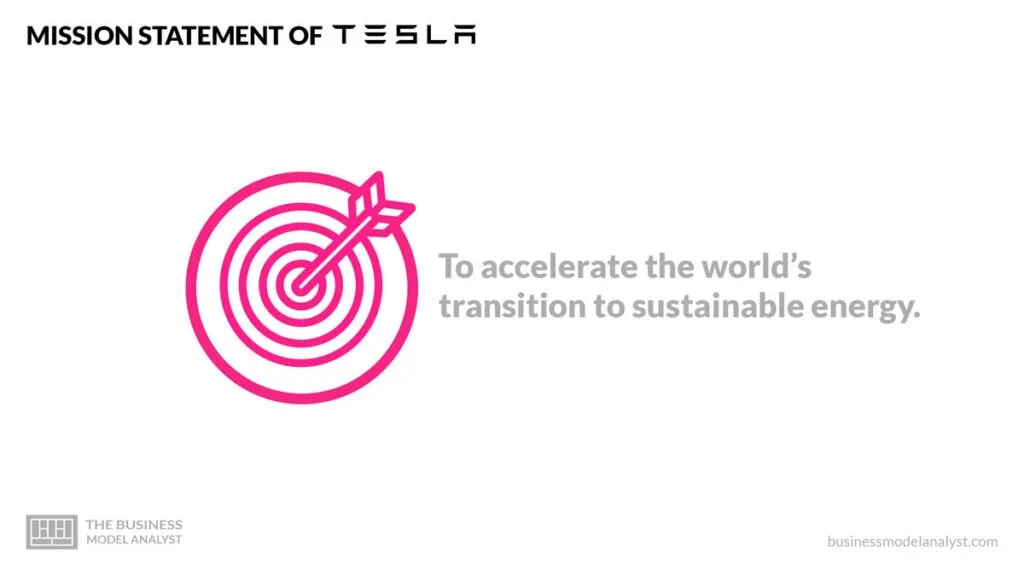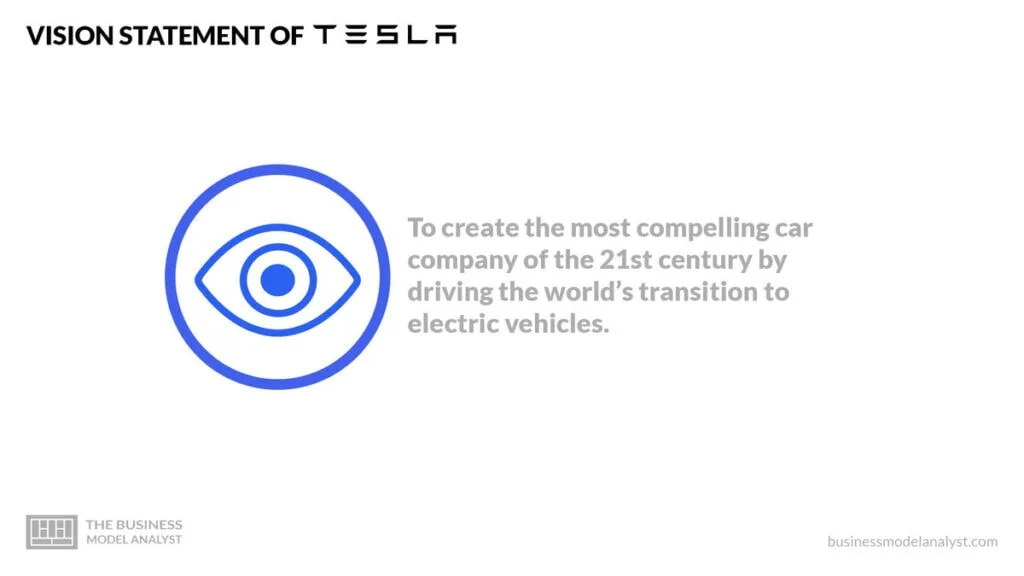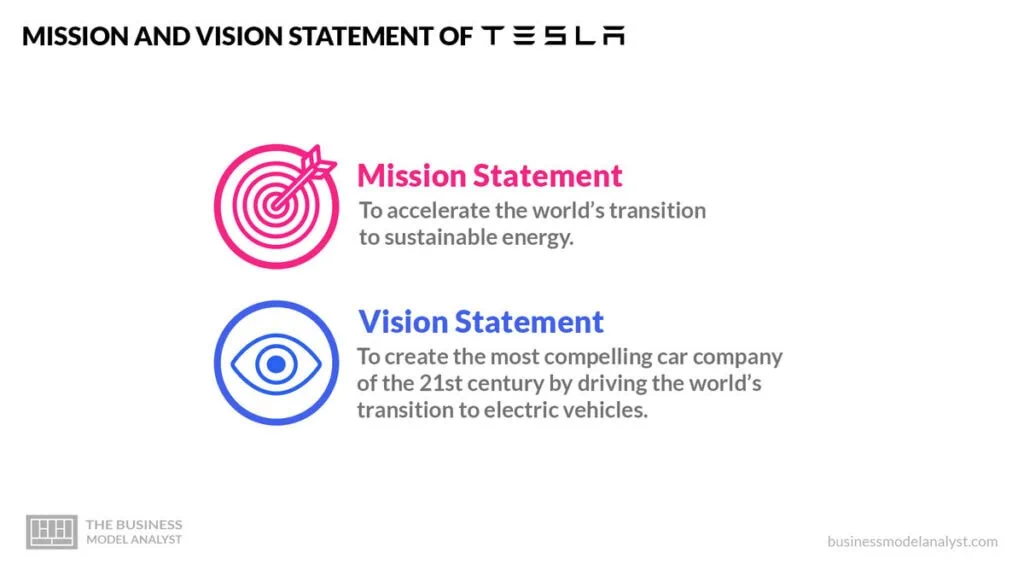The Tesla mission statement is “to accelerate the world’s transition to sustainable energy.” And the Tesla vision statement is “to create the most compelling car company of the 21st century by driving the world’s transition to electric vehicles.”
Since its founding in 2003, Tesla, Inc., has been a driving force behind the revolution of the motor vehicle industry, focusing on providing reliable, efficient, and sustainable electric cars.
Their mission and vision statements have served as a foundation for their strategy of transitioning to electric-powered automobiles; this ambition has resulted in rapid expansion across their various businesses and enabled them to become one of today’s leading car manufacturing companies. This success was further cemented in 2018 when Tesla became the top seller of plug-in passenger cars worldwide. It continues to be a major source of motivation for both existing manufacturers and startups alike.
Tesla’s corporate vision statement outlines its ambition to be a pioneer in transitioning other automobile manufacturers into an electric model future. Their mission statement provides insight into the methods that management plans to utilize to accomplish this goal; it is evident that Tesla has dedicated itself to continuously enhancing its business performance and brand image. To ensure alignment with its grand ambitions, Tesla has implemented core values that guide all internal practices — propelling them toward achieving both its mission and vision statements.
Contents
Tesla’s Mission Statement

Tesla’s mission statement is “to accelerate the world’s transition to sustainable energy.” This mission reflects the company’s commitment to helping lead a global shift away from fossil fuels and towards renewable forms of energy. As technological advances have enabled access to more efficient and effective renewable energy sources, Tesla has responded by expanding its scope beyond just electric vehicles into solar energy production, battery storage, and other related technologies. This broader focus recognizes that innovation in the areas of sustainable energy technology can help reduce greenhouse gas emissions and contribute to a healthier planet.
This new mission statement was implemented under CEO Elon Musk’s leadership to better reflect the company’s current strategic direction going forward. Previously, Tesla’s corporate mission was “to accelerate the world’s transition to sustainable transport.” While electric vehicle production still remains one of Tesla’s core strengths, it is no longer seen as their sole focus moving forward. Instead, this new phrase more accurately describes Tesla’s overarching goal — namely, accelerating a worldwide shift towards sustainability-oriented solutions on multiple fronts.
Tesla’s mission statement can be divided into the following key points:
Acceleration
Tesla realizes that its mission to accelerate the adoption of sustainable energy solutions will not be met without the creation of innovative and efficient products. To this end, Tesla has developed a variety of advanced technologies to further develop its vehicles and create revolutionary advancements. These include their Autopilot feature, which allows for semi-autonomous driving capabilities, as well as their unique Battery Management Systems that maximize battery life and reduce waste.
On top of these developments, Tesla is also focusing on improving the charging infrastructure around the world, with superchargers being available at convenient locations around the globe.
The advancements made by Tesla are intended to be applied to other sectors outside the automotive industry, such as energy storage systems for residential homes and large-scale commercial businesses alike. The company aims to push the industry toward more sustainable products on a larger scale than just cars so that everyone benefits from this transition. By doing so, it demonstrates its commitment to accelerating an environmentally friendly lifestyle within society and inspiring others to continue this path forward toward sustainability transformation across all commercial markets.
Global Transition
Tesla’s corporate vision statement addresses global transition, referring to its strategy of providing more energy-efficient products and solutions to a wider customer base. By creating clean energy alternatives and increasing availability in different parts of the world, Tesla is helping transform the way people consume energy. The company is working hard towards reducing carbon emissions and greenhouse gases while developing innovative technologies that can be used to generate sustainable electricity. The main goal is to provide customers with integrated solutions that will power their homes and electric vehicles safely and efficiently.
In addition, Tesla strives to reduce society’s dependence on fossil fuels. If successful, it would eliminate the need for thousands of oil wells, coal plants, gas rigs, refineries, and other infrastructure associated with traditional fuel sources. This would have a dramatic impact on climate change as well as human health outcomes all over the globe by eliminating dangerous pollutants from our air. It could also serve an economic purpose by lowering energy prices for both consumers and businesses worldwide.
Sustainable energy
Sustainable energy is a key component of Tesla Inc.’s mission statement, which states that the organization is committed to “accelerating the world’s transition to sustainable energy.” This suggests that Tesla has plans to expand its business beyond just electric automobiles and related products, as well as expanding into renewable energy sources such as solar power.
The shift away from simply “sustainable transport” in previous mission statements signals an evolution towards meeting the growing demands of sustainability-minded consumers and general stakeholders interested in environmental conservation. By focusing its mission statement on sustainable energy, Tesla shows its commitment to responding to stakeholder interests while also positioning itself for potential expansion opportunities.
Investing in both efficient and renewable energy sources could help reduce emissions drastically over time, since many countries now rely heavily on fossil fuels for their electricity generation. By discovering new ways to make use of sustainable energy sources, Tesla could help promote better stewardship of the environment, which benefits everyone in the long run — especially given that pollution levels are continuing to rise globally.
Therefore, it is clear why ‘sustainable energy’ occupies a strong position within any corporate mission statement today: it communicates a sense of purpose that goes beyond simply producing more effective products; it increases overall awareness about sustainability; and it provides potential pathways for future diversification within the industry while also addressing societal trends.
Tesla’s Vision Statement

Tesla’s corporate vision statement of “to create the most compelling car company of the 21st century by driving the world’s transition to electric vehicles” is an ambitious one and implies that Tesla firmly believes in its ability to become a major player in the automotive industry. The company is confident about its products and believes that it can transition from being merely an automobile manufacturer to becoming a full-fledged mobility solutions provider for people who want sustainable and efficient transportation options.
This statement also reflects Tesla’s eagerness to revolutionize transportation by innovating new technologies and integrating them into their automobiles. With this dedication, Tesla ensures that its vision will be realized, as customers have come to expect nothing but the best from them.
The scope of this vision encompasses a global audience, which requires extensive resources and expertise in understanding consumer behavior and trends across all countries where they operate. To meet these objectives, Tesla deploys various strategies, such as consistent research and development activities backed up by dedicated marketing campaigns targeted at customers living in different parts of the globe.
In addition, it focuses on developing clean energy production capabilities through solar panels installed in some locations and developing autonomous vehicle technologies, including autopilot software for cars, so as to meet customer expectations regarding sustainability and convenience while using their vehicles.
To stay competitive against giants like Toyota, General Motors, Ford, Volkswagen, and more, Tesla faces the daunting task of keeping their products up to date at a lower cost than what they offer. To combat this obstacle, Tesla has adopted two organic strategies: releasing novel services regularly and engaging in strategic mergers and acquisitions with tech companies to gain exclusive technologies for future product developments. Through these measures, Tesla strives to remain ahead of competitors while maintaining profitability and sustainability in the long run.
Tesla’s vision statement can be outlined in the following points:
The most compelling
Tesla’s vision statement vows to be the most compelling in the industry. This means that their top priority is to prove themselves as leaders and innovators in the automotive sector by displaying business excellence. To do this, Tesla has emphasized its necessity for pushing other manufacturers into embracing electric vehicles and utilizing green energy to benefit humanity in this day and age. All of Tesla’s efforts are focused on making these concepts and its vision a reality.
In line with this objective, Tesla puts significant effort into creating groundbreaking products that strengthen its position as a leader in the market. Their success thus far serves as proof of their dedication to achieving this goal; they have released several revolutionary models such as semi-trucks, solar roof tiles, and electric luxury car models (Model S, X, and 3).
In addition to having breakthrough technology incorporated into all their cars, they also ensure that safety is a major part of each product they develop through extensive tests/ trials conducted before releasing them to the public. They also continuously research new ways to enhance old designs or create more efficient ones without compromising quality, which helps maintain customer loyalty.
21st Century
Tesla’s vision statement’s 21st-century element focuses on modern technology and sustainable transport solutions. The company is committed to utilizing advanced scientific techniques to innovate, reduce environmental impacts, increase efficiency, and improve the customer experience.
By emphasizing cutting-edge Internet of Things (IoT) technologies such as regenerative braking and Autopilot self-driving features, Tesla demonstrates strong foresight into the future of transportation. They demonstrate an understanding that embracing technology can create better opportunities for people around the world who rely on alternative travel methods, such as electric vehicles. They also understand that, in order to make these products accessible to everyone, it is important to offer an affordable price point while still ensuring quality products and services.
The “21st-century” aspect reflects the company’s dedication to creating resources that are reliable in terms of cost-effectiveness and sustainability throughout various global markets. In addition, their focus on offering autonomous features gives customers peace of mind when using Tesla vehicles with advanced safety systems designed to help avoid collisions or other dangerous situations.
Driving the world’s transition to electric vehicles
This element is a clear indication that Tesla has a global mission to promote sustainable transportation solutions. This includes an emphasis on green energy and a commitment to creating electric cars that are able to perform competitively in the international market. The use of the term “world” implies that Tesla intends for its operations and impact to be expansive in terms of geographical reach. As indicated by their mission statement, this ambition is indeed global in scope, as they aim for maximum market penetration across many different nations and regions.
To facilitate this vision of driving the world’s transition towards electric vehicles, Tesla has taken various steps, such as opening production plants all over the globe in places like China, Germany, and the Netherlands, among others. This allows them access to new markets and customers. Increasing customer access through these facilities spread around the world ensures wider visibility for their products. It helps potential customers understand how electric cars can meet their needs without compromising performance or capability.
Core Values
Tesla’s core values include “doing the best, taking risks, respect, constant learning, and environmental consciousness.” These values are integral to Tesla’s success and guide the overall attitudes and practices of all stakeholders associated with the company.
The idea of doing the best is reflected in Tesla’s commitment to high-quality performance, which has seen the company advance technologically. This emphasizes employees pushing themselves to meet their targets while also engaging in calculated risk-taking to drive innovation.
Respect is another core value that Tesla recognizes as being essential to its corporate environment, understanding that it helps foster not only solidarity between different players involved with them, but also boosts collective learning by creating an enabling atmosphere conducive to exchanging ideas and sharing knowledge.
Constant learning goes hand-in-hand with this mutual respect between staff members at Tesla; it encourages creativity by allowing team members to share new ideas that may result in growth for the company. It ultimately enables those working at Tesla to become better equipped when tackling any task given or challenges faced within their professional roles.
Environmental consciousness is a key value encouraged within the organization, where employees are encouraged to make decisions that pay attention to protecting natural resources as well as aim towards sustainability goals set out by global agreements such as the Paris Agreement on climate change or the Sustainable Development Goals (SDGs). As opposed to simply focusing on achieving profitability, these values instead encourage attempts at achieving a balance between economic aspirations and social impact goals related to the environment when making business decisions.
Conclusion
Tesla has implemented an ambitious mission and vision statement that emphasizes its dedication to leading the transition toward electric-powered automobiles. They have gone above and beyond to ensure success by creating core values to help guide internal practices.
Through the implementation of advanced technology, the production of innovative vehicles, and the building of strong customer relationships — Tesla has been able to achieve international recognition as one of today’s leading car manufacturing companies. By continuing to strive for excellence in all areas related to its mission and vision statements, Tesla stands poised for further success as it continues its journey into the future of an electric-powered revolution.


